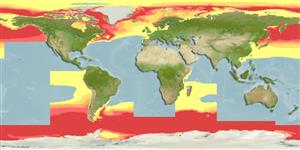Sagittoidea |
Phragmophora |
Eukrohniidae
Environment: milieu / climate zone / गहराई सीमा / distribution range
पारिस्थितिकी
; गहराई सीमा 0 - 3000 m (संदर्भ 1812). Temperate; -2°C - 17°C (संदर्भ 1705); 80°N - 76°S, 0°E - 0°E
Arctic, Atlantic, Indo-Pacific and the Antarctic. Common in Southeast Pacific.
Length at first maturity / आकार / Weight / Age
परिपक्व अवधि: Lm ? range ? - ? cm Max length : 4.3 cm BL पुल्लिंग / अलिंग; (संदर्भ 2255)
Bipolar distribution with tropical submergence. Epipelagic in high latitudes and mesopelagic (Ref. 116362) or bathypelagic (Ref. 116365) in lower latitudes (Ref. 2255). Found at depths between 50 and 200 m during winter and spring and below 200 m during summer and autumn (Ref. 1812).
Life cycle and mating behavior
परिपक्व अवधि | पुनरुत्पत्ति | मछलीऔ का अंडे देना | Eggs | Fecundity | Larvae
Members of the phylum Chaetognatha are hermaphroditic. Mating behavior: A preliminary visual signaling behavior for species recognition is observed to prevent predation. Life cycle: Eggs directly develop into miniature adults (hatchlings).
Hansson, H.G. 1998 NEAT (North East Atlantic Taxa): South Scandinavian marine "Aschelminth" (except Nematoda, which are treated separately and some other species poor phyla Check-List. Internet pdf Ed., http://www.tmbl.gu.se (संदर्भ 429)
IUCN Red List Status
(संदर्भ 130435: Version 2025-1)
CITES status (संदर्भ 108899)
Not Evaluated
CMS (संदर्भ 116361)
Not Evaluated
Threat to humans
Human uses
| FishSource |
साधन
अधिक जानकारी
Trophic EcologyFood items (preys)संघटक आहारआहार खपतपरभक्षी Life cycleपुनरुत्पत्तिपरिपक्व अवधिFecundityमछलीऔ का अंडे देनाEggsEgg developmentLarvae PhysiologyOxygen consumption
Human RelatedStamps, coins, misc.
इंटरनेट स्रोत
Estimates based on models
Preferred temperature
(Ref.
115969): 0.2 - 5.6, mean 1.6 (based on 2391 cells).
Fishing Vulnerability
Low vulnerability (10 of 100).
Price category
Unknown.
